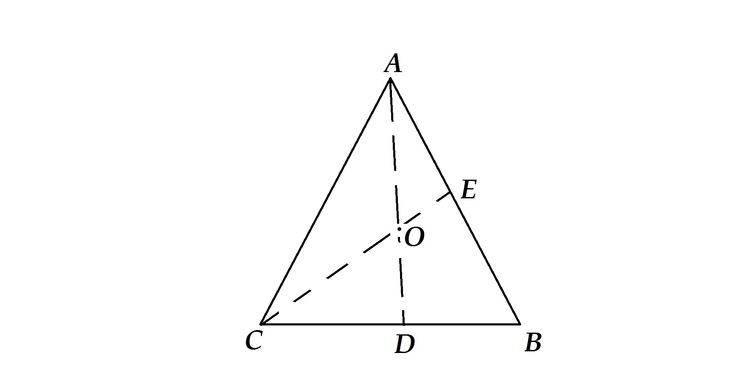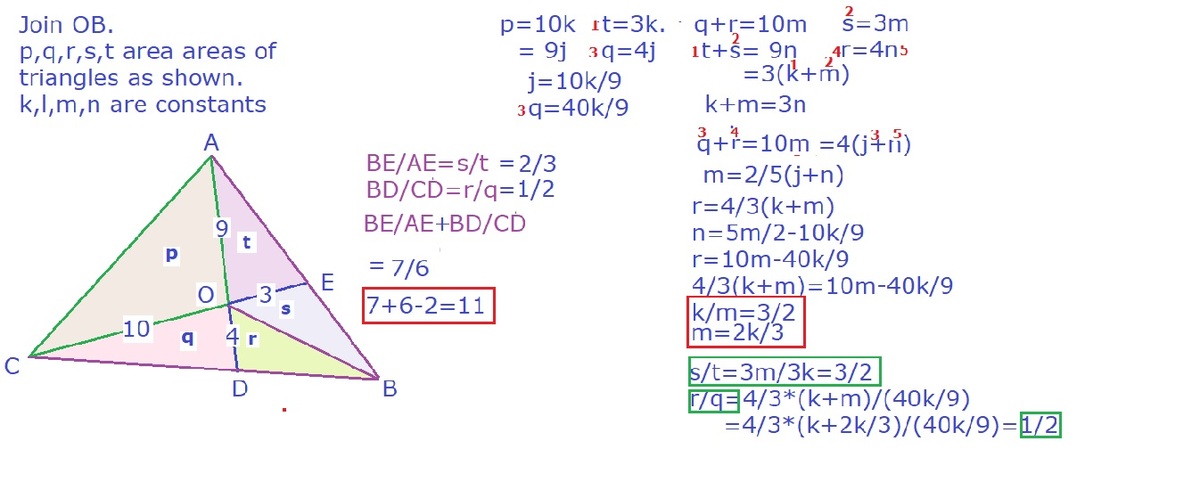Is the Given Information Sufficient?
 Let
O
be a point inside
△
A
B
C
such that
Let
O
be a point inside
△
A
B
C
such that
O E O C = 3 1 0 and O D O A = 4 9 .
If
E A B E + D C B D = n m ,
where g cd ( m , n ) = 1 , find the value of m + n − 2 .
The answer is 11.
This section requires Javascript.
You are seeing this because something didn't load right. We suggest you, (a) try
refreshing the page, (b) enabling javascript if it is disabled on your browser and,
finally, (c)
loading the
non-javascript version of this page
. We're sorry about the hassle.
5 solutions
WoW !! Physics in maths I can't even imagine !!
Log in to reply
Why not? And actually we can mathematically define and prove all "physics" terms and facts we use, so it has nothing to do with physics at all. I used the same method, BTW.
All we need to do is to put masses a , b and c to the points A , B and C correspondingly, so that pairs have their centers of mass at points D and E while all three have the center at O .
Masses can be easily found from two conditions:
3a + 3b = 10c and 4b + 4c = 9a
then a = 4 , b = 6 and c = 3 is one of the solutions. After that we can easily find all other ratios remembering all masses from pairs are coming to to their centers.
Log in to reply
My concept of mass moment is not clear when can I get it ....s plz suggest some links
Menelaus theorem is also a way.
Nice.. I used vector algebra to solve the problem. I thought there was no way to avoid it :)
Interesting! I used similarity though.
Log in to reply
extra lines and other garbage all over the place... yet still very nice :D
I made the question with the help of Cordinate Geometry .
i jst wanna know what does (COM) stand for ? .. great solution btw
Let the areas of △ A C O , △ A E O , △ E B O , △ B D O and △ C D O be a , b , c , d and e respectively. Then we have:
b a = O E O C = 3 1 0 ⇒ b = 1 0 3 a . . . 1
c d + e = O E O C = 3 1 0 ⇒ d + e − 3 1 0 c = 0 . . . 2
e a = O D O A = 4 9 ⇒ e = 9 4 a . . . 3
d b + c = O D O A = 4 9 ⇒ b + c − 4 9 d = 0 . . . 4
Substituting eq. 3 in eq. 2 and multiplying throughout by 4 9 :
⇒ 4 9 d + 4 9 9 4 a − 4 9 3 1 0 c = 0 ⇒ 4 9 d + a − 2 1 5 c = 0 . . . 5
Substituting eq. 1 in eq. 4:
⇒ 1 0 3 a + c − 4 9 d = 0 . . . 6
Adding eq. 5 to eq. 6 ⇒ 1 0 1 3 a − 2 1 3 ) c = 0 ⇒ c = 5 1 a
Substituting c = 5 1 a in eq. 5:
⇒ 4 9 d + a − 2 1 5 5 1 a = 0 ⇒ d = 9 2 a
Now we have: E A B E + D C B D = b c + e d = 5 1 × 3 1 0 + 9 2 × 4 9 = 3 2 + 2 1 = 6 7 = n m
Therefore, the required answer m + n − 2 = 7 + 6 − 2 = 1 1
is there a proof that a/b = OC/OE ??
Log in to reply
Amr, please note that △ A C O and △ A E O has the same height or perpendicular distance between A and C B . Let this height be h , then we have:
The area of △ A C O = a = O C × h
The area of △ A E O = b = O E × h
Therefore, b a = O E × h O C × h = O E O C
Join BO and extend it to F on AC.
Now, I don't know how to prove it and I want proof of it too(maybe it needs mass point geometry or it can be done using Ceva's theorem too I guess.)
A D O D + C E O E + B F O F = 1
1 3 3 + 1 3 4 + B F O F = 1
B F O F = 1 3 6
O F O B = 6 7
Also, I saw the following somewhere(Wikipedia though) and want to know its proof
O F B O = E A B E + D C B D
Hence, E A B E + D C B D = 6 7
PLEASE, I want both the proofs(I think Ceva's theorem will be enough but I am just not getting it.
Log in to reply
Cevas theorem apply to the triangle BCE and vertices A,O,D,and once more Cevas theroem aplied to the triangle DBA and vertices A,O,D gives solution after minut or two calculating...
1st formula hint: Ratio of the sides = Ratio of the area
2nd formula I'm still working with the proof. Might come back later.
Log in to reply
Can you pls share both of them here? -
https://brilliant.org/discussions/thread/need-derviation-of-some-formulas-help/?auto login key=vmP7GpRs3iSjLclsIqkJdUq19ijGOweqRnsVmvFnAa#comment-a3f558715e92
Cevas theorem apply to the triangle BCE and vertices A,O,D,and once more Cevas theroem aplied to the triangle DBA and vertices A,O,D gives solution after minut or two calculating...

For my Solution One must needed to know some physics !!
So Put the Point masses at the various points .
Put mass 3 kg at C and now using the concept that mass moment about the centre of mass of an system are equal so at point E we must have to put mass of 10 kg
So Mass at the COM of CE is 13 kg which is present at the point O
Similarly at point 'A' mass would be 4 kg and at the point 'D' it is 9 kg
So by equating mass moment about point 'E'
B E × 6 = E A × 4 E A B E = 6 4 . . . . ( 1 ) .
And by equating mass moment about point 'D'
B D × 6 = D C × 3 C D B D = 6 3 . . . . ( 2 ) .
By adding 1 and 2 we get
C D B D + E A B E = 6 7 .
m = 7 .
n = 6 .